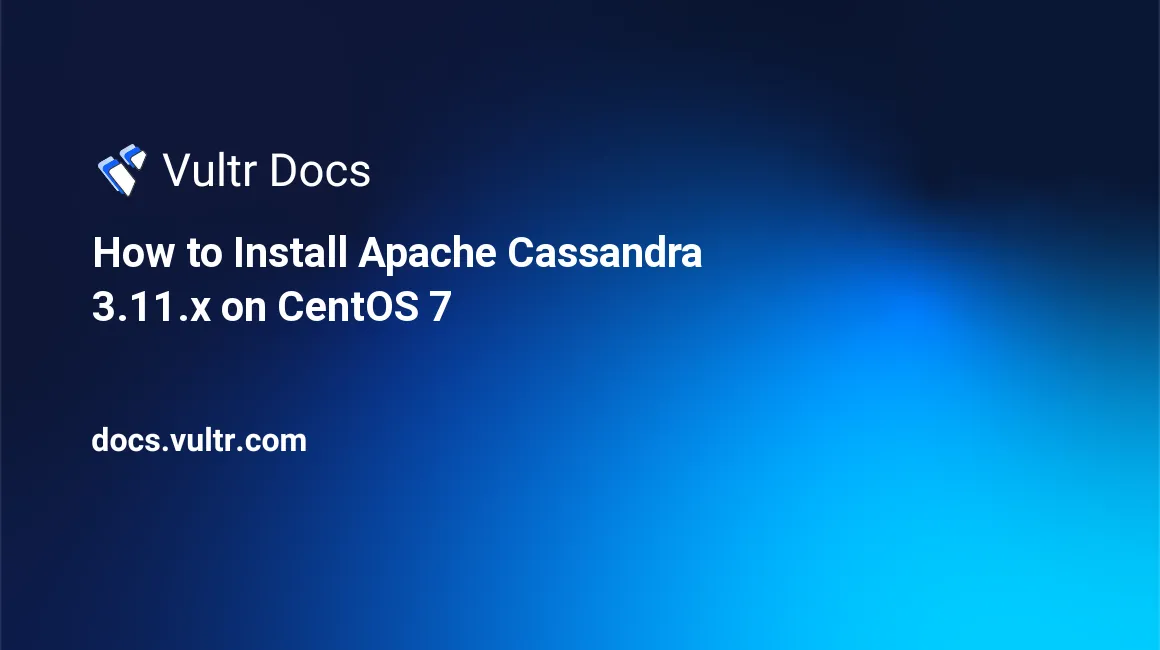
Apache Cassandra is a free and open source NoSQL database management system that is designed to provide scalability, high availability, and uncompromised performance.
In this article, I will guide you through installing the latest stable release of Apache Cassandra, Apache Cassandra 3.11.2, on a CentOS 7 server instance.
Prerequisites
- A fresh Vultr CentOS 7 x64 server instance with at least 4GB of memory. Insufficient memory will cause Apache Cassandra to exit abnormally.
- A sudo user.
- The server instance has been updated to the latest stable status.
Step 1: Install OpenJDK JRE 8
Apache Cassandra requires the latest release of Java 8. For that you can choose to install the latest release of OpenJDK JRE 1.8 as below:
sudo yum install -y java-1.8.0-openjdkHaving OpenJDK JRE 1.8 installed, you can confirm the installation result:
java -versionThe output will be similar to the following:
openjdk version "1.8.0_161"
OpenJDK Runtime Environment (build 1.8.0_161-b14)
OpenJDK 64-Bit Server VM (build 25.161-b14, mixed mode)Optionally, you can create the JAVA_HOME environment variable as follows:
echo "JAVA_HOME=$(readlink -f /usr/bin/java | sed "s:bin/java::")" | sudo tee -a /etc/profile
source /etc/profile
echo $JAVA_HOMEStep 2: Install Python 2.7, if it's missing on your system
Apache Cassandra requires Python 2.7 rather than Python 3. If you operate Apache Cassandra in a Python 3 environment, you may have trouble launching the cqlsh shell of Apache Cassandra.
First, determine the existence and version of Python on your machine:
python -VOn CentOS 7, the output normally will be:
Python 2.7.5As you see, Python 2.7 is a built-in component on CentOS 7. However, if it's missing for some reason, you can install it by running the following command:
sudo yum install python -yStep 3: Install the latest stable release of Apache Cassandra
Create the Apache Cassandra 3.11.x YUM repo:
cat <<EOF | sudo tee -a /etc/yum.repos.d/cassandra311x.repo
[cassandra]
name=Apache Cassandra
baseurl=https://www.apache.org/dist/cassandra/redhat/311x/
gpgcheck=1
repo_gpgcheck=1
gpgkey=https://www.apache.org/dist/cassandra/KEYS
EOFInstall Apache Cassandra 3.11.2 using the above YUM repo:
sudo yum install cassandra -y
sudo systemctl daemon-reloadStep 4: Test the installation of Apache Cassandra
Start the Apache Cassandra daemon:
sudo service cassandra startThe output will be:
Starting cassandra (via systemctl): [ OK ]If you want to make Apache Cassandra automatically start at system boot, run the following command:
sudo chkconfig cassandra onNext, use the nodetool program to show the status of Apache Cassandra on current node:
nodetool statusThe output will resemble the following:
Datacenter: datacenter1
=======================
Status=Up/Down
|/ State=Normal/Leaving/Joining/Moving
-- Address Load Tokens Owns (effective) Host ID Rack
UN 127.0.0.1 103.65 KiB 256 100.0% e977023b-7dd7-4e89-9ee7-aaa4c45df51c rack1You can use the cqlsh shell to interact with Apache Cassandra:
cqlsh localhostThe output will be similar to the following:
Connected to Test Cluster at localhost:9042.
[cqlsh 5.0.1 | Cassandra 3.11.2 | CQL spec 3.4.4 | Native protocol v4]
Use HELP for help.
cqlsh>For now, just type exit and then press Enter to quit the cqlsh shell.
If you want to stop Apache Cassandra, execute the following command:
sudo service cassandra stop
No comments yet.